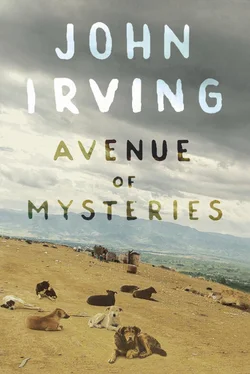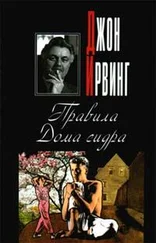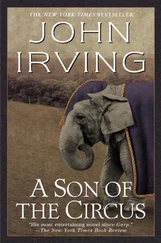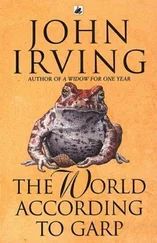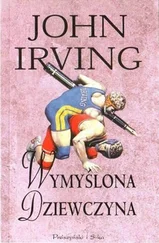“¡Madre!” Sister Gloria once more cried, as if Mother Mary were the nun’s single savior and confidante — truly, as the nun’s responsive prayer maintained, her one and only guide.
That was when el gringo bueno slipped and fell forward into the bathtub; the soapy water sloshed over the sides of the tub, drenching the bathroom floor. The hippie, now on his hands and knees, had enough presence of mind to turn off the running water. The tub, at last, could drain, but as the water quickly receded, those kindergartners still in the bathroom — for the most part, they’d been too afraid to run away — saw the emerging American flag (torn in two) on the gringo Christ’s bare ass.
Sister Gloria saw the flag, too — a tattoo of such secular certainty that it clashed with the tattoo of the Agonizing Jesus. To the instinctively disapproving nun, a satanic discord seemed to emanate from the naked boy in the emptying tub.
Juan Diego had not moved. He knelt on the bathroom floor, the spilled bathwater touching his thighs. Around him, the cringing kindergartners lay curled in wet balls. It must have been the future writer developing in him, but Juan Diego thought of the amphibious troops killed in recapturing Corregidor, some of them not much older than children. He thought of the wild promise he’d made to the good gringo, and he was thrilled — the way, at fourteen, you can be thrilled by an utterly unrealistic vision of the future.
“Ahora y siempre — now and forever,” one of the soaking-wet kindergartners was whimpering.
“Now and forever,” Juan Diego said, more confidently. He knew this was a promise to himself — to seize every opportunity that looked like the future, from this moment forward.
In the corridor outside Edward Bonshaw’s classroom at Niños Perdidos was a bust of the Virgin Mary with a tear on her cheek. The bust stood on a pedestal in a corner of the second-floor balcony. There was often a beet-red smudge on Mary’s other cheek; it looked like blood to Esperanza — every week she wiped it off, but the next week it was back. “Maybe it is blood,” she’d told Brother Pepe.
“It can’t be,” Pepe told her. “There have been no reported stigmata cases at Lost Children.”
On the landing between the first and second floors was the suffer-the-little-children statue of San Vicente de Paul with two infants in his arms. Esperanza reported to Brother Pepe that she’d also wiped blood off the hem of the saint’s cloak. “Every week I wipe it off, but it comes back!” Esperanza had said. “It must be miraculous blood.”
“It can’t be blood, Esperanza,” was all Pepe would say about it.
“You don’t know what I see, Pepe!” Esperanza said, pointing to her fiery eyes. “And whatever it is, it leaves a stain.”
They were both right. It was not blood, but every week it came back and it left a stain. The dump kids had had to lie low with the beet juice after the episode with the good gringo in their bathtub; they’d had to cut back on their nighttime visits to Zaragoza Street, too. Señor Eduardo and Brother Pepe — not to mention that witch Sister Gloria and the other nuns — were keeping a close eye on them. And Lupe was right about the gifts el gringo bueno could afford for them: they were less than outstanding presents.
The hippie had no doubt haggled over the cheap religious figures he’d bought from the Christmas-parties place, the virgin shop on Independencia. One was a small totem, in the category of a statuette — more of a figurine than a lifelike figure — but the Guadalupe virgin was life-size.
The Guadalupe virgin was actually a little bigger than Juan Diego. She was his present. Her blue-green mantle — a kind of cloak or cape — was traditional. Her belt, or what looked like a black girdle, would one day give rise to the speculation that Guadalupe was pregnant. Long after the fact, in 1999, Pope John Paul II invoked Our Lady of Guadalupe as Patroness of the Americas and Protectress of Unborn Children. (“That Polish pope,” Juan Diego would later rail against him — and his unborn business.)
The virgin-shop Guadalupe didn’t look pregnant, but this Guadalupe mannequin appeared to be about fifteen or sixteen — and she had breasts. The boobs made her seem not religious at all. “She’s a sex doll!” Lupe immediately said.
Of course, that wasn’t strictly true; there was, however, a sex-doll aspect to the Guadalupe figure, though Juan Diego could not undress her and she didn’t have movable limbs (or recognizable reproductive parts).
“What’s my present?” Lupe asked the hippie boy.
The good gringo asked Lupe if she forgave him for sleeping with her mother. “Yes,” Lupe said, “but we can’t ever get married.”
“That sounds pretty final,” the hippie said, when Juan Diego translated Lupe’s answer to the forgiveness question.
“Show me the present,” was all Lupe said.
It was a Coatlicue figurine, as ugly as any replica of the goddess. Juan Diego thought it was a blessing that the hideous statuette was small — it was even smaller than Dirty White. El gringo bueno had no clue how to pronounce the name of the Aztec goddess; Lupe, in her hard-to-follow fashion, couldn’t manage to help him say it.
“Your mom said you admired this weird mother goddess,” the good gringo explained to Lupe; he didn’t sound so sure.
“I love her,” Lupe told him.
Juan Diego had always found it hard to believe that one goddess could have so many contradictory attributes attached to her, but it was easy for him to see why Lupe loved her. Coatlicue was an extremist — a goddess of childbirth and of sexual impurity and wrongful behavior. Several creation myths were connected to her; in one, she was impregnated by a ball of feathers that fell on her while she was sweeping a temple — enough to piss anyone off, Juan Diego thought, but Lupe said this was the kind of thing she could imagine happening to their mother, Esperanza.
Unlike Esperanza, Coatlicue wore a skirt of serpents. She was basically dressed in writhing snakes; she wore a necklace of human hearts and hands and skulls. Coatlicue’s hands and feet had claws; her breasts were flaccid. In the figurine the good gringo gave to Lupe, Coatlicue’s nipples were made of rattlesnake rattles. (“Too much nursing, maybe,” Lupe observed.)
“But what do you like about her, Lupe?” Juan Diego had asked his sister.
“Some of her own children vowed to kill her,” Lupe had answered him. “Una mujer difícil.” A difficult woman.
“Coatlicue is a devouring mother; the womb and the grave coexist in her,” Juan Diego explained to the hippie boy.
“I can see that,” the good gringo said. “She looks deadly, man on wheels,” the hippie more confidently stated.
“Nobody messes with her!” Lupe proclaimed.
Even Edward Bonshaw (always looking on the bright side) found Lupe’s Coatlicue figurine frightening. “I understand there are repercussions that come from the ball-of-feathers mishap, but this goddess is not very sympathetic-looking,” Señor Eduardo said to Lupe, as respectfully as anyone possibly could.
“Coatlicue didn’t ask to be born who she was,” Lupe answered the Iowan. “She was sacrificed — supposedly to do with creation. Her face was formed by two serpents — after her head was cut off and the blood spurted from her neck in the form of two gigantic snakes. Some of us,” Lupe told the new missionary, pausing for Juan Diego’s translation to catch up, “don’t have a choice about who we are.”
“But—” Edward Bonshaw began.
“I am who I am,” Lupe said; Juan Diego rolled his eyes when he repeated this to Señor Eduardo. Lupe pressed the grotesque Coatlicue totem to her cheek; it was apparent that she didn’t just love the goddess because the good gringo had given her the statuette.
Читать дальше
